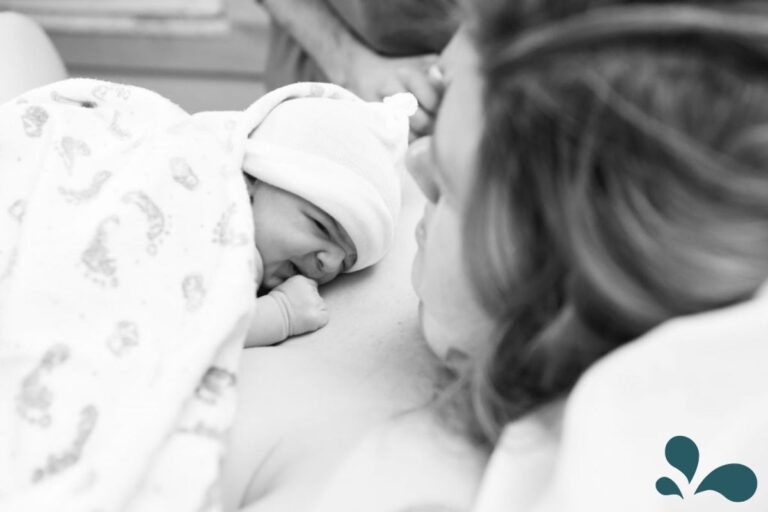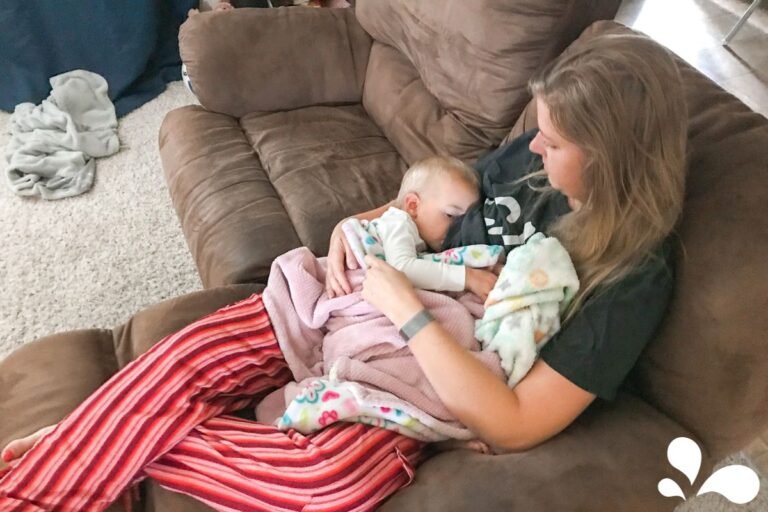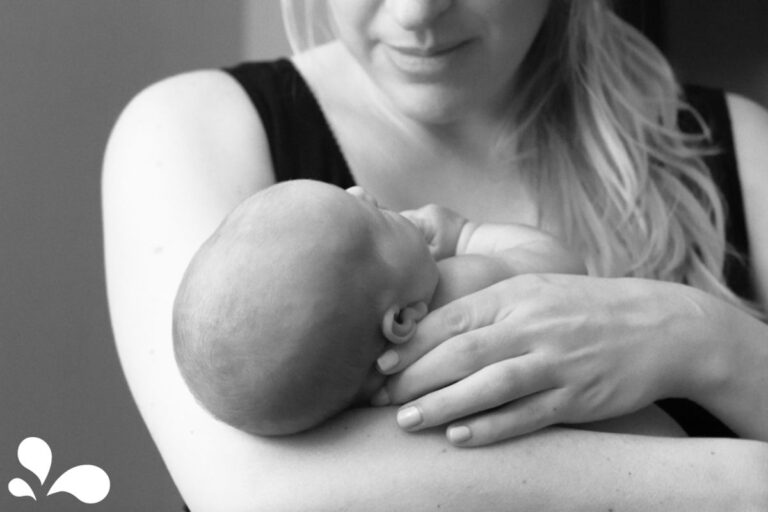What is a nipple shield and why would I use it?

A nipple shield is a flexible silicone nipple that is placed over the mother’s nipple during breastfeeding. You might receive one in the hospital if your baby is having difficulty latching. Latching issues can be caused from tongue-tie or from inverted or flat nipples.
Nipple shields can be helpful if you have flat or inverted nipples, a preterm delivery, or a low-birth-weight baby. They should be a short-term solution, and should always be used under the guidance and direction of an International Board Certified Lactation Consultant (IBCLC). Nipple shields may reduce the amount of milk that baby is able to remove from the breast, which may lead to plugged ducts and mastitis. And nobody wants those. 😣 Learn how to prevent mastitis.
If you need to use a nipple shield, you should also have a plan to wean baby from it. An IBCLC is a great resource to help you create your weaning plan. Below, you’ll find a weaning list that I’ve put together to give you an idea of what to expect from a weaning plan.
How to wean from using a nipple shield?
Weaning from a nipple shield can be difficult and takes time, so let’s get through this together.
Here are 5 things to help you wean:
- Work with an IBCLC
- Have patience with yourself and your baby
- Get lots of skin-to-skin contact anytime you can
- Offer the breast first before using the shield (work up to doing full feeds without the shield)
Tip: If you have short, flat, or inverted nipples you can massage your nipples and/or pump before breastfeeding for a couple minutes to help “pull” the nipple out – This also helps to get milk flowing to give baby a quick “reward” when latched and sucking
- Check that your baby has a good latch; if not, break the suction and try again
To give you even more help, I’ve included the transcript to my IGTV recording about nipple shields.
00:00 Hey Mamas. Today I am talking about nipple shields. And this is an example of a nipple shield. There are multiple sizes and shapes of nipple shields. This is just one kind of them, but I just wanted to show you guys kind of what they look like. So, with a Nipple Shield I kind of have a love-hate relationship with these. I feel that sometimes nurses and lactation consultants in the hospital will give these when it’s not necessary, and sometimes they are given for a good reason and very, very useful. So I’m going to be talking a little bit about both of those. But a Nipple Shield is just thin silicone nipple that has multiple holes in it here. And this goes over your nipple to help baby be able to latch on to the breast more easily. And sometimes baby will just latch onto the nipple. Sometimes they’ll do a good big latch and latch on really well to the breast as well.
01:14 And that makes it a little bit more effective and helpful. Because sometimes with the nipple shield, I find that it decreases nipple stimulation, which can decrease breast milk supply and decrease the amount of milk transferred to baby. So, I always recommend when using a nipple shield that you’re working with an IBCLC. And that is an international board certified lactation consultant. I am an IBCLC and sometimes the lactation consultants in the hospital are IBCLCs, but sometimes they are nurses that have had just a little bit of breastfeeding training and they don’t fully have breastfeeding certifications and the full scope of knowledge that an IBCLC has to be able to fully assess if a nipple shield is needed and what else might be able to help you better. So I always recommend talking to an IBCLC before using a nipple shield. If you are going to use a nipple shield, I recommend, with an IBCLC, doing a consultation where you do what’s called a, “weigh, feed, weigh” with baby.
02:39 So what they’ll do is they’ll weigh baby before they feed, then you’ll do a feeding with the nipple shield, then they’ll weigh baby after the feed and you’ll see how much milk is transferred. I have had multiple consultations with moms that use nipple shields with their babies. Sometimes I have had baby get a full three-ounce feeding in the 20 minutes that they eat, and that is great with the nipple shield. I have also had babies that have fed for 30+ minutes and only transferred a fraction of an ounce; and that is frustrating for both mom and baby. So obviously baby’s not getting enough food, but mom is feeling like they’ve been feeding for so long that babies should be getting enough food, not understanding why baby is still fussy, and then needing to supplement after and everything. And so it can cause lots of complications. Without having that knowledge that baby’s not getting enough milk.
03:44 It can cause baby to not grow well and have some failure-to-thrive issues, which is why it’s so important to work with an IBCLC when using a nipple shield so that you can know if baby is transferring enough milk or not. In the cases of breastfeeding going really well with nipple shields, and even when they’re not, working with an IBCLC to create a plan to wean off of the nipple shield is a great idea. I have had so many consultations where the biggest complaint of the nipple shield is how difficult it is to use, especially when wanting to breastfeed in public, someone going out of the house and needing to use it. It can be difficult. It fills with the milk and then it can spill all over when you’re trying to take it off and different things, so it can be really complicating and frustrating to use one of these at times.
04:42 And so creating a plan to wean baby off is great. Some babies will just wean off on their own, which is amazing, and will just be able to go right to breastfeeding without the nipple shield, without any complications. In those cases, it’s often because the nipple shield was used because baby was born a little premature or a little bit small and had a small mouth, which is why you were using this to help them breastfeed in the first place. And so as they get older and bigger and their mouth gets bigger, they’re able to get onto the breast without the nipple shield a lot more easily. In some cases, like those with flat or inverted nipples, it can be a little bit more tricky, and creating a plan and a process to help pull the nipples out before breastfeeding can help to wean off the nipple shield more easily; and again, I cannot stress it more.
05:45 That’s why it’s so important to work with an IBCLC when using a nipple shield so that you can know how to use it, that you’re using the right size. I mentioned that these come in different shapes and sizes, and you want to make sure that you’re using the right size for your nipple so that it can work the best that it can. And then creating a plan to wean and and working with the IBCLC to know that baby is transferring enough milk. So, with all of that information you can see why sometimes using a nipple shield is a little bit more complicated. And if you are having difficulties with breastfeeding in the hospital or right after baby is born, I would not use this as a first go-to solution. Make sure that you are being fully assessed; both you, your baby, and the feeding to see that baby is latching well. And if that’s an issue, there are different ways to help baby latch well. It could be tongue tie or lip tie issue that if that is resolved can then help with the feeding without using a nipple shield. It can be a couple of different things. With…If baby’s mouth is just a little bit too small, Um, just assessing how the feeding is actually going. Assessing baby’s mouth, how their tongue moves, and all of those can really play into how a feeding goes. And if you get a full, good assessment, we can figure out how to fix it, possibly without using a nipple shield.
07:33 If a nipple shield is still needed, then that’s fine, but we want to make sure, again, baby is getting enough milk transferred with that feeding. And so, always work with an IBCLC to help with the nipple shield to know that it’s working properly, that things are going well with the milk transferring, baby’s gaining weight appropriately, having enough wet and poopy diapers, and that breastfeeding can then…we can have a plan to wean off of this, to have just breastfeeding without the nipple shield and have you have the best breastfeeding journey and experience that you can, and the breastfeeding journey that…an experience that you want. So if you have any other questions about nipple shields, please let me know. Send me a message and I will be happy to answer them for you. Thanks mamas.








